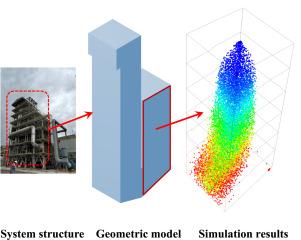Numerical investigation of flow behavior and reaction characteristics in a liquid waste incinerator
IF 4.6
2区 工程技术
Q2 ENGINEERING, CHEMICAL
引用次数: 0
Abstract
Chemical manufacturing processes generate substantial quantities of hazardous organic waste liquids and incineration serves as an effective method for treating such waste streams. To elucidate the operational characteristics of waste liquid incinerators, numerical simulations of incinerators was conducted for obtaining data which were hard measured by experiments. A DPM approach is utilized to capture the flow and reaction characteristics and the influence of key parameters, including atomized droplet diameter, atomization velocity, and spray angle, on combustion completeness, temperature distribution, and concentration distribution, etc. were analyzed. The results demonstrate that the droplet diameter significantly affects the trajectory within the furnace. Larger droplets possess greater inertia, traverse a wider spatial range, and exhibit a higher probability of wall impingement. Furthermore, larger droplets facilitate a broader spatial distribution of the waste liquid, contributing to a more uniform temperature field. Increase of spray angle enhance the mixing between droplets and air which leads to improved uniformity in the concentration field. Elevating the atomization velocity promotes the formation of a more well-defined conical droplet distribution; however, it concurrently increases the likelihood of droplets impinging on the furnace bottom and side walls. These three key parameters are highly interrelated, necessitating coordinated consideration during parameter optimization.

废液焚烧炉内流动特性及反应特性的数值研究
化学生产过程产生大量的有害有机废液,焚烧是处理这类废液流的有效方法。为了阐明废液焚烧炉的运行特性,对焚烧炉进行了数值模拟,获得了实验难以测量的数据。采用DPM方法捕捉了流动和反应特性,分析了雾化液滴直径、雾化速度、喷射角等关键参数对燃烧完整性、温度分布、浓度分布等的影响。结果表明,液滴直径对炉内轨迹有显著影响。较大的液滴具有更大的惯性,穿越更宽的空间范围,并且表现出更高的撞击壁面的可能性。液滴越大,废液的空间分布越广,温度场越均匀。喷淋角的增大促进了液滴与空气的混合,从而提高了浓度场的均匀性。提高雾化速度有利于形成更明确的锥形液滴分布;然而,它同时增加了液滴撞击炉底和侧壁的可能性。这三个关键参数是高度相关的,在参数优化时需要协调考虑。
本文章由计算机程序翻译,如有差异,请以英文原文为准。
求助全文
约1分钟内获得全文
求助全文
来源期刊

Powder Technology
工程技术-工程:化工
CiteScore
9.90
自引率
15.40%
发文量
1047
审稿时长
46 days
期刊介绍:
Powder Technology is an International Journal on the Science and Technology of Wet and Dry Particulate Systems. Powder Technology publishes papers on all aspects of the formation of particles and their characterisation and on the study of systems containing particulate solids. No limitation is imposed on the size of the particles, which may range from nanometre scale, as in pigments or aerosols, to that of mined or quarried materials. The following list of topics is not intended to be comprehensive, but rather to indicate typical subjects which fall within the scope of the journal's interests:
Formation and synthesis of particles by precipitation and other methods.
Modification of particles by agglomeration, coating, comminution and attrition.
Characterisation of the size, shape, surface area, pore structure and strength of particles and agglomerates (including the origins and effects of inter particle forces).
Packing, failure, flow and permeability of assemblies of particles.
Particle-particle interactions and suspension rheology.
Handling and processing operations such as slurry flow, fluidization, pneumatic conveying.
Interactions between particles and their environment, including delivery of particulate products to the body.
Applications of particle technology in production of pharmaceuticals, chemicals, foods, pigments, structural, and functional materials and in environmental and energy related matters.
For materials-oriented contributions we are looking for articles revealing the effect of particle/powder characteristics (size, morphology and composition, in that order) on material performance or functionality and, ideally, comparison to any industrial standard.
 求助内容:
求助内容: 应助结果提醒方式:
应助结果提醒方式:


